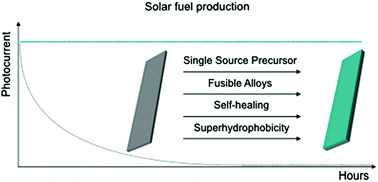Emerging approaches to stabilise photocorrodible electrodes and catalysts for solar fuel applications
Abstract
The generation of solar fuels through artificial photosynthesis could, in principle, solve our looming energy crisis. Photoelectrochemical devices use light-absorbers, such as semiconductors, to capture sunlight and generate excited states of charge carriers that are transported to catalysts for the production of renewable fuels. However, many photoactive materials are chemically unstable in contact with an aqueous electrolyte solution and therefore need protection through coating by a material that is chemically robust to prevent corrosion and conducting to allow transfer of charges to a solution-exposed catalytic site. Commonly used coating procedures and materials are often challenging to scale and therefore unlikely to be applicable on a scale to cover global energy demand. In this mini review, we present recent advances revolving around unconventional, yet technically simpler and less costly routes to protecting and activating photocorrodible electrodes for solar fuels application. We focus on two emerging approaches: (i) the use of single source precursor chemistry for the preparation of bi-functional protecting and catalytically active layers, and (ii) the use of low-temperature fusible eutectic alloys as protecting and conducting layers that can be easily activated for catalysis.



 Please wait while we load your content...
Please wait while we load your content...